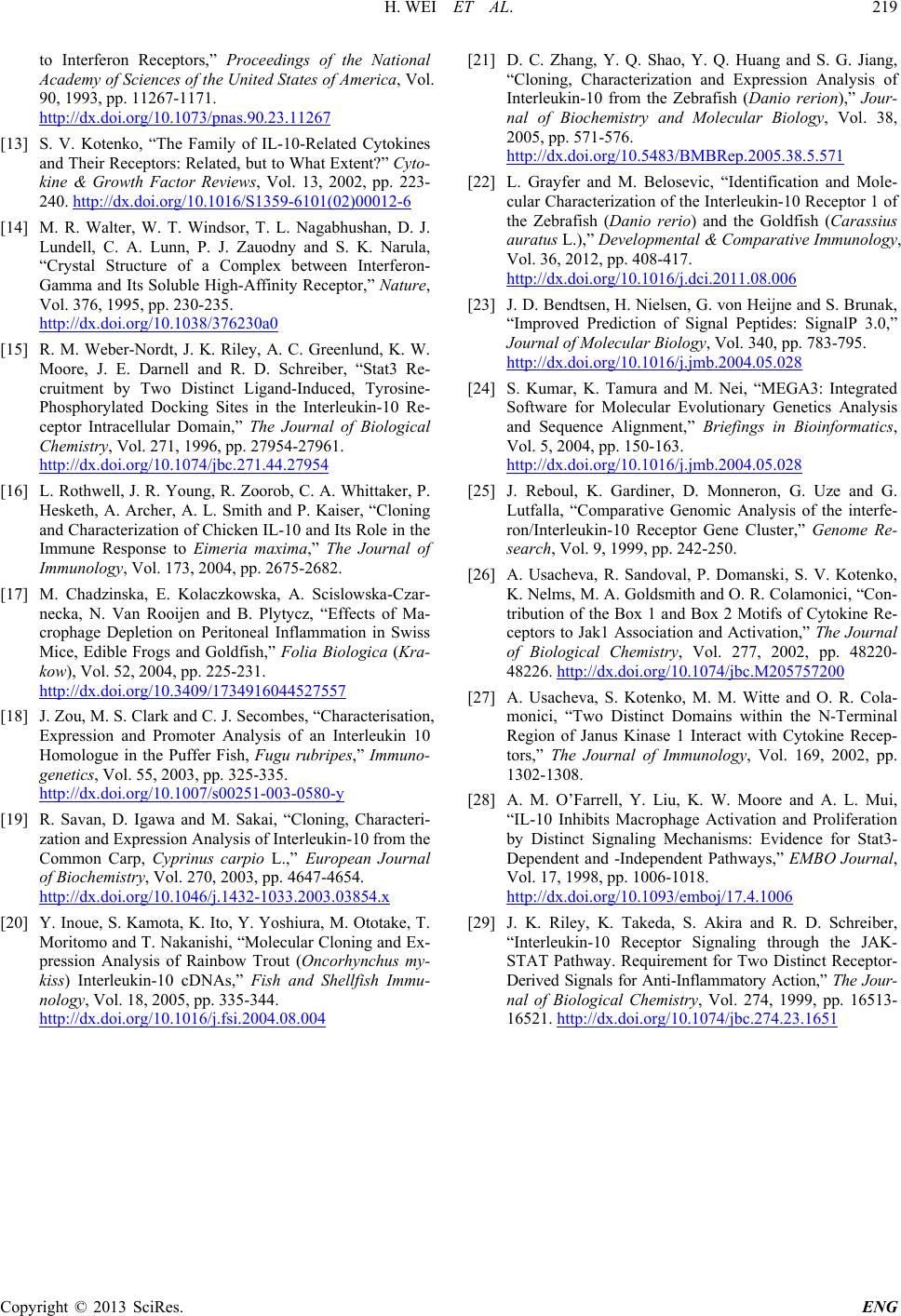
H. WEI ET AL.
Copyright © 2013 SciRes. ENG
to Interferon Receptors,” Proceedings of the National
Academy of Sciences of the United States of America, Vol.
90, 1993, pp. 11267-1171.
http://dx.doi.org/10.1073/pnas.90.23.11267
[13] S. V. Kotenko, “The Family of IL-10-Related Cytokines
and Their Receptors: Related, but t o What Extent?” Cyto-
kine & Growth Factor Reviews, Vol. 13, 2002, pp. 223-
240. http://dx.doi.org/10.1016/S1359-6101(02)00012-6
[14] M. R. Walter, W. T. Windsor, T. L. Nagabhushan, D. J.
Lundell, C. A. Lunn, P. J. Zauodny and S. K. Narula,
“Crystal Structure of a Complex between Interferon-
Gamma and Its Soluble High-Affinity Receptor,” Nature,
Vol. 376, 1995, pp. 230-235.
http://dx.doi.org/10.1038/376230a0
[15] R. M. Weber-Nordt, J. K. Riley, A. C. Greenlund, K. W.
Moore, J. E. Darnell and R. D. Schreiber, “Stat3 Re-
cruitment by Two Distinct Ligand-Induced, Tyrosine-
Phosphorylated Docking Sites in the Interleukin-10 Re-
ceptor Intracellular Domain,” The Journal of Biological
Chemistry, Vol. 271, 1996, pp. 27954-27961.
http://dx.doi.org/10.1074/jbc.271.44.27954
[16] L. Rothwell, J. R. Young, R. Zoorob, C. A. Whittaker, P.
Hesketh, A. Archer, A. L. Smith and P. Kaiser, “Cloning
and Characterization of Chicken IL-10 and Its Role in the
Immune Response to Eimeria maxima,” The Journal of
Immunology, Vol. 173, 2004, pp. 2675-2682.
[17] M. Chadzinska, E. Kolaczkowska, A. Scislowska-Czar-
necka, N. Van Rooijen and B. Plytycz, “Effects of Ma-
crophage Depletion on Peritoneal Inflammation in Swiss
Mice, Edible Frogs and Goldfish,” Folia Biologica (Kra-
kow), Vol. 52, 2004, pp. 225-231.
http://dx.doi.org/10.3409/1734916044527557
[18] J. Zou, M. S. Clark and C. J. Secombe s, “Characterisation,
Expression and Promoter Analysis of an Interleukin 10
Homologue in the Puffer Fish, Fugu rubripes,” Immuno-
genetics, Vol. 55, 2003, pp. 325-335.
http://dx.doi.org/10.1007/s00251-003-0580-y
[19] R. Savan, D. Igawa and M. Sakai, “Cloning, Characteri-
zation and Expression Ana lysi s of Interleukin-10 from the
Common Carp, Cyprinus carpio L.,” European Journal
of Biochemistry, Vol. 270, 2003, pp. 4647-4654.
http://dx.doi.org/10.1046/j.1432-1033.2003.03854.x
[20] Y. Inoue, S. Kamot a, K. Ito, Y. Yoshiura, M. Ototake, T.
Moritomo and T. Nakanishi, “Molecular Cloning and Ex-
pression Analysis of Rainbow Trout (Oncorhynchus my-
kiss) Interleukin-10 cDNAs,” Fish and Shellfish Immu-
nology, Vol. 18, 2005, pp. 335-344.
http://dx.doi.org/10.1016/j.fsi.2004.08.004
[21] D. C. Zhang, Y. Q. Shao, Y. Q. Huang and S. G. Jiang,
“Cloning, Characterization and Expression Analysis of
Interleukin-10 from the Zebrafish (Danio rerion),” Jour-
nal of Biochemistry and Molecular Biology, Vol. 38,
2005, pp. 571-576.
http://dx.doi.org/10.5483/BMBRep.2005.38.5.571
[22] L. Grayfer and M. Belosevic, “Identification and Mole-
cular Characterization of the Interleukin-10 Receptor 1 of
the Zebrafish (Danio rerio) and the Goldfish (Carassius
auratus L.),” Developmental & Comparative Immunology,
Vol. 36, 2012, pp. 408-417.
http://dx.doi.org/10.1016/j.dci.2011.08.006
[23] J. D. Bendtsen, H. Ni elsen, G. von Heijne and S. Brunak,
“Improved Prediction of Signal Peptides: SignalP 3.0,”
Journal of Molecular Biology, Vol. 340, pp. 783-795.
http://dx.doi.org/10.1016/j.jmb.2004.05.028
[24] S. Kumar, K. Tamura and M. Nei, “MEGA3: Integrated
Software for Molecular Evolutionary Genetics Analysis
and Sequence Alignment,” Briefings in Bioinformatics,
Vol. 5, 2004, pp. 150-163.
http://dx.doi.org/10.1016/j.jmb.2004.05.028
[25] J. Reboul, K. Gardiner, D. Monneron, G. Uze and G.
Lutfalla, “Comparative Genomic Analysis of the interfe-
ron/Interleukin-10 Receptor Gene Cluster,” Genome Re-
search, Vol. 9, 1999, pp. 242-250.
[26] A. Usacheva, R. Sandoval, P. Domanski, S. V. Kotenko,
K. Nelms, M. A. Goldsmith and O. R. Colamonici, “Con-
tribution of the Box 1 and Box 2 Motifs of Cytokine Re-
ceptors to Jak1 Association and Activation,” The Journal
of Biological Chemistry, Vol. 277, 2002, pp. 48220-
48226. http://dx.doi.org/10.1074/jbc.M205757200
[27] A. Usacheva, S. Kotenko, M. M. Witte and O. R. Cola-
monici, “Two Distinct Domains within the N-Terminal
Region of Janus Kinase 1 Interact with Cytokine Recep-
tors,” The Journal of Immunology, Vol. 169, 2002, pp.
1302-1308.
[28] A. M. O’Farrell, Y. Liu, K. W. Moore and A. L. Mui,
“IL-10 Inhibits Macrophage Activation and Proliferation
by Distinct Signaling Mechanisms: Evidence for Stat3-
Dependent and -Independent Pathways,” EMBO Journal,
Vol. 17, 1998, pp. 1006-1018.
http://dx.doi.org/10.1093/emboj/17.4.1006
[29] J. K. Riley, K. Takeda, S. Akira and R. D. Schreiber,
“Interleukin-10 Receptor Signaling through the JAK-
STAT Pathway. Requirement for Two Distinct Receptor-
Derived Signals for Anti-Inflammatory Action,” The Jour-
nal of Biological Chemistry, Vol. 274, 1999, pp. 16513-
16521. http://dx.doi.org/10.1074/jbc.274.23.1651